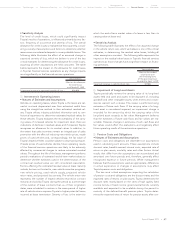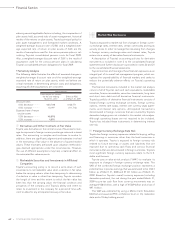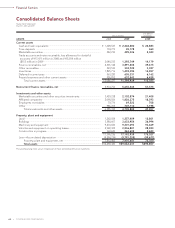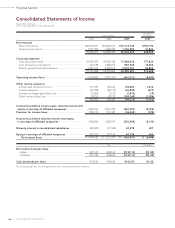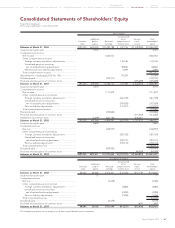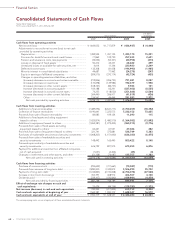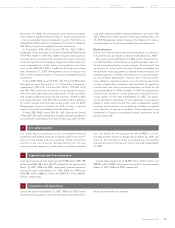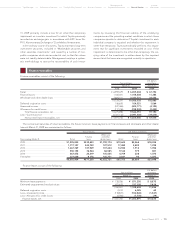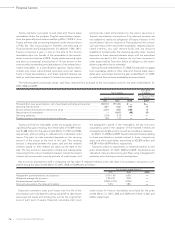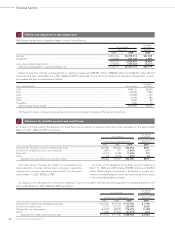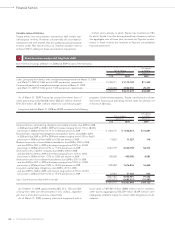Toyota 2009 Annual Report Download - page 72
Download and view the complete annual report
Please find page 72 of the 2009 Toyota annual report below. You can navigate through the pages in the report by either clicking on the pages listed below, or by using the keyword search tool below to find specific information within the annual report.
Financial Section
TOYOTA MOTOR CORPORATION
70
Toyota generally warrants its products against certain manufac-
turing and other defects. Provisions for product warranties are
provided for specific periods of time and/or usage of the prod-
uct and vary depending upon the nature of the product, the
geographic location of the sale and other factors. Toyota records
a provision for estimated product warranty costs at the time the
related sale is recognized based on estimates that Toyota will
incur to repair or replace product parts that fail while under war-
ranty. The amount of accrued estimated warranty costs is pri-
marily based on historical experience as to product failures as
well as current information on repair costs. The amount of war-
ranty costs accrued also contains an estimate of warranty claim
recoveries to be received from suppliers. Product recalls and
voluntary service campaigns are recorded when they are deter-
mined to be probable and reasonably estimable.
Research and development costs are expensed as incurred.
Research and development costs were ¥890,782 million,
¥958,882 million and ¥904,075 million ($9,204 million) for the
years ended March 31, 2007, 2008 and 2009, respectively.
Cash and cash equivalents
Cash and cash equivalents include all highly liquid investments
with original maturities of three months or less, that are readily
convertible to known amounts of cash and are so near maturity
that they present insignificant risk of changes in value because
of changes in interest rates.
Marketable securities
Marketable securities consist of debt and equity securities. Debt
and equity securities designated as available-for-sale are carried
at fair value with unrealized gains or losses included as a com-
ponent of accumulated other comprehensive income in share-
holders’ equity, net of applicable taxes. Individual securities
classified as available-for-sale are reduced to net realizable
value for other-than-temporary declines in market value. In
determining if a decline in value is other-than-temporary, Toyota
considers the length of time and the extent to which the fair
value has been less than the carrying value, the financial condi-
tion and prospects of the company and Toyota’s ability and
intent to retain its investment in the company for a period of
time sufficient to allow for any anticipated recovery in market
value. Realized gains and losses, which are determined on the
average-cost method, are reflected in the statement of income
when realized.
Security investments in non-public companies
Security investments in non-public companies are carried at cost
as fair value is not readily determinable. If the value of a non-pub-
lic security investment is estimated to have declined and such
decline is judged to be other-than-temporary, Toyota recognizes
the impairment of the investment and the carrying value is
reduced to its fair value. Determination of impairment is based on
the consideration of such factors as operating results, business
plans and estimated future cash flows. Fair value is determined
principally through the use of the latest financial information.
Finance receivables
Finance receivables are recorded at the present value of the
related future cash flows including residual values for finance
leases.
Allowance for credit losses
Allowance for credit losses are established to cover probable
losses on receivables resulting from the inability of customers to
make required payments. The allowance for credit losses is
based primarily on the frequency of occurrence and loss severi-
ty. Other factors affecting collectibility are also evaluated in
determining the amount to be provided.
Losses are charged to the allowance when it has been deter-
mined that payments will not be received and collateral cannot
be recovered or the related collateral is repossessed and sold.
Any shortfall between proceeds received and the carrying cost of
repossessed collateral is charged to the allowance. Recoveries
are reversed from the allowance for credit losses.
Allowance for residual value losses
Toyota is exposed to risk of loss on the disposition of off-lease
vehicles to the extent that sales proceeds are not sufficient to
cover the carrying value of the leased asset at lease termination.
Toyota maintains an allowance to cover probable estimated loss-
es related to unguaranteed residual values on its owned portfolio.
The allowance is evaluated considering projected vehicle return
rates and projected loss severity. Factors considered in the deter-
mination of projected return rates and loss severity include histor-
ical and market information on used vehicle sales, trends in lease
returns and new car markets, and general economic conditions.
Management evaluates the foregoing factors, develops several
potential loss scenarios, and reviews allowance levels to deter-
mine whether reserves are considered adequate to cover the
probable range of losses.
The allowance for residual value losses is maintained in
amounts considered by Toyota to be appropriate in relation to
the estimated losses on its owned portfolio. Upon disposal of
the assets, the allowance for residual losses is adjusted for the
difference between the net book value and the proceeds from
sale.
Inventories
Inventories are valued at cost, not in excess of market, cost
being determined on the “average-cost” basis, except for the
cost of finished products carried by certain subsidiary compa-
nies which is determined on the “specific identification” basis or
“last-in, first-out” (“LIFO”) basis. Inventories valued on the LIFO
basis totaled ¥283,735 million and ¥150,110 million ($1,528 mil-
lion) at March 31, 2008 and 2009, respectively. Had the “first-in,
first-out” basis been used for those companies using the LIFO
basis, inventories would have been ¥30,360 million and ¥58,980
million ($600 million) higher than reported at March 31, 2008
and 2009, respectively.



